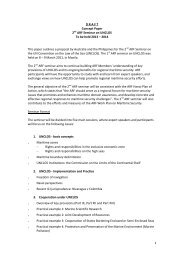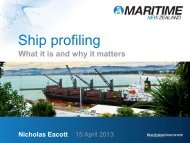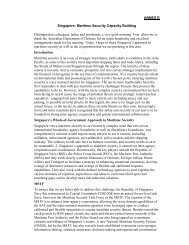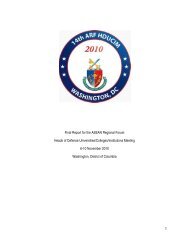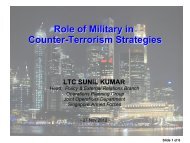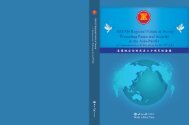Flagships and Activities of ASEAN-ISIS - ASEAN Regional Forum
Flagships and Activities of ASEAN-ISIS - ASEAN Regional Forum
Flagships and Activities of ASEAN-ISIS - ASEAN Regional Forum
You also want an ePaper? Increase the reach of your titles
YUMPU automatically turns print PDFs into web optimized ePapers that Google loves.
<strong>Flagships</strong> <strong>and</strong> <strong>Activities</strong> <strong>of</strong> <strong>ASEAN</strong>-<strong>ISIS</strong>ARF Inter-Sessional Support Group on Confidence Building Measures <strong>and</strong>Preventive DiplomacyIntroductionHelsinki, 28-30 March 2007By Malayvieng SakonhninhomActing Director-General <strong>of</strong> IFAChair <strong>of</strong> <strong>ASEAN</strong>-<strong>ISIS</strong><strong>ASEAN</strong>-<strong>ISIS</strong> is a short form for <strong>ASEAN</strong> Institutes for Strategic <strong>and</strong> International Studies.When <strong>ASEAN</strong>-<strong>ISIS</strong> was <strong>of</strong>ficially formed <strong>and</strong> registered with the <strong>ASEAN</strong> Secretariat in 1988, itwas a small group composed <strong>of</strong> only five institutes <strong>of</strong> the original <strong>ASEAN</strong> members. Later in 1995,the <strong>ASEAN</strong>-<strong>ISIS</strong> admitted the Institute <strong>of</strong> International Relations (IIR) <strong>of</strong> Vietnam as a newmember, followed by Cambodia Institute for Cooperation <strong>and</strong> Peace (CICP) in 1997, <strong>and</strong> the LaoInstitute <strong>of</strong> Foreign Affairs (IFA) in 1999. While the individuals from Brunei Darussalam, affiliatedwith the Ministry <strong>of</strong> Foreign Affairs, have been participating in <strong>ASEAN</strong>-<strong>ISIS</strong> for a number <strong>of</strong> years,it was <strong>of</strong>ficially a member <strong>of</strong> <strong>ASEAN</strong>-<strong>ISIS</strong> in 2000, following the establishment <strong>of</strong> the BruneiDarussalam Institute <strong>of</strong> Policy <strong>and</strong> Strategic Studies (BDIPSS) 1 . Therefore, this expansion makes<strong>ASEAN</strong>-<strong>ISIS</strong> much larger. However, <strong>ASEAN</strong>-<strong>ISIS</strong> is still facing a challenge to include MyanmarInstitute for Strategic <strong>and</strong> International Studies as a membership.<strong>ASEAN</strong>-<strong>ISIS</strong> is a key actor in the birth <strong>and</strong> development <strong>of</strong> a process that has come to beknown as Track 2 diplomacy in the region. This Track 2 diplomacy is the conduct <strong>of</strong> policydialogue among government <strong>of</strong>ficials, think tanks, researchers <strong>and</strong> other policy analysts <strong>and</strong>practitioners in their private capacity on various issues <strong>of</strong> the economic, political-security, <strong>and</strong> thesocial.Over the past decade, <strong>ASEAN</strong>-<strong>ISIS</strong> has gone through <strong>and</strong> overcome many challenges <strong>and</strong>received a number <strong>of</strong> significant achievements. This brief paper will summarize the picture <strong>of</strong>flagships <strong>and</strong> achievements <strong>of</strong> <strong>ASEAN</strong>-<strong>ISIS</strong> <strong>and</strong> then its challenges.1 Hadi Soesastro, Clara Joewono <strong>and</strong> Carolina Hern<strong>and</strong>ez (2006), Introduction, in Hadi Soestro, Clara Joewono &Carolina G. Hern<strong>and</strong>ez (eds.), Twenty Two Years <strong>of</strong> <strong>ASEAN</strong> <strong>ISIS</strong>: Origin, Evolution <strong>and</strong> Challenges <strong>of</strong> Track TwoDiplomacy, <strong>ASEAN</strong> <strong>ISIS</strong>: CSIS.1
<strong>Flagships</strong> <strong>and</strong> Achievements <strong>of</strong> <strong>ASEAN</strong>-<strong>ISIS</strong>The main objectives <strong>of</strong> <strong>ASEAN</strong>-<strong>ISIS</strong> are (1) to cooperate among <strong>ASEAN</strong> think tanks tostrengthen research development on strategic <strong>and</strong> international problems <strong>of</strong> the region <strong>and</strong><strong>ASEAN</strong>’s cooperation, <strong>and</strong> (2) to cooperate <strong>and</strong> strengthen cooperation with other think tanks in theregion <strong>and</strong> research institutions outside <strong>ASEAN</strong> <strong>and</strong> the world to strengthen peace <strong>and</strong> developmentin the region <strong>and</strong> to contribute to the world order <strong>and</strong> peace as a whole.It has to be recognized that <strong>ASEAN</strong>-<strong>ISIS</strong> has played a significant role in contributing to themanagement <strong>of</strong> regional order <strong>and</strong> security challenges in Southeast Asia <strong>and</strong> beyond. The power <strong>of</strong>ideas has been the key element <strong>of</strong> <strong>ASEAN</strong>-<strong>ISIS</strong>’ contribution in this regard 2 . This can be observedthrough the development <strong>of</strong> <strong>ASEAN</strong>-<strong>ISIS</strong> from the beginning. When <strong>ASEAN</strong>-<strong>ISIS</strong> was <strong>of</strong>ficiallylaunched in 1988, it was conceived as a regional non-governmental association at producing policyinputs for consideration by governments <strong>and</strong> decision-makers in <strong>ASEAN</strong> countries. During almosttwo decades, <strong>ASEAN</strong>-<strong>ISIS</strong> has established itself as a very important Track 2 network recognized bythe governments <strong>of</strong> <strong>ASEAN</strong> countries. Regular meetings between <strong>ASEAN</strong>-<strong>ISIS</strong> heads <strong>and</strong> senior<strong>of</strong>ficials <strong>of</strong> <strong>ASEAN</strong> member states are a good example 3 . Acting as “Track 2”, <strong>ASEAN</strong>-<strong>ISIS</strong>provides policy inputs to their respective Track 1 by organizing regional workshops, meetings,conferences, seminars, etc. It provides venues for experts <strong>and</strong> scholars in various fields related toregional peace <strong>and</strong> security to meet <strong>and</strong> exchange views with each other as well as with theirrespective government <strong>of</strong>ficials, civil society groups in order to reach the aim <strong>of</strong> mutualunderst<strong>and</strong>ing among various sectors in the region regarding common concerns.It is significant to recognize that among these important venues, some have become the“flagship activities” <strong>of</strong> <strong>ASEAN</strong>-<strong>ISIS</strong> namely the Asia Pacific Roundtable (APR) for ConfidenceBuilding <strong>and</strong> Conflict Resolution, the <strong>ASEAN</strong>-<strong>ISIS</strong> Colloquium on Human Rights (AICOHR), <strong>and</strong>the <strong>ASEAN</strong> People’s Assembly (APA). These three important flagships, for example, are to carrythe basic ideals <strong>and</strong> missions <strong>of</strong> <strong>ASEAN</strong>-<strong>ISIS</strong> to promote open <strong>and</strong> inclusive exchanges to come up2 Rizal Sukma (2006), <strong>ASEAN</strong> <strong>ISIS</strong> <strong>and</strong> Political-Security Cooperation in Asia-Pacific, in Hadi Soestro, ClaraJoewono & Carolina G. Hern<strong>and</strong>ez (eds.), Twenty Two Years <strong>of</strong> <strong>ASEAN</strong> <strong>ISIS</strong>: Origin, Evolution <strong>and</strong> Challenges <strong>of</strong>Track Two Diplomacy, <strong>ASEAN</strong> <strong>ISIS</strong>: CSIS.3 Suchit Bunbongkarn (2006), The Future <strong>of</strong> <strong>ASEAN</strong> <strong>ISIS</strong>, in Hadi Soestro, Clara Joewono & Carolina G. Hern<strong>and</strong>ez(eds.), Twenty Two Years <strong>of</strong> <strong>ASEAN</strong> <strong>ISIS</strong>: Origin, Evolution <strong>and</strong> Challenges <strong>of</strong> Track Two Diplomacy, <strong>ASEAN</strong> <strong>ISIS</strong>:CSIS.2
with innovative ideas that will help to enhance peace, security, prosperity <strong>and</strong> the well being <strong>of</strong> thepeoples in the region.APR is known as the largest security forum for the Asia-Pacific region <strong>of</strong> Track 2 <strong>and</strong> it isarguably the most important venue which brings together experts, think tanks, policy studyinstitutes, <strong>and</strong> policy makers from Asia-Pacific <strong>and</strong> beyond in the informal, friendly <strong>and</strong> frankenvironment annually in Malaysia to discuss the major security issues <strong>and</strong> challenges confrontingthe region <strong>and</strong> produce new ideas <strong>and</strong> proposals for cooperation on security issue. This year,<strong>ASEAN</strong>-<strong>ISIS</strong> will convene its 21 st APR.APA has also been organized with the engagement <strong>of</strong> a wide range <strong>of</strong> civil societyorganizations, non-governmental organizations <strong>and</strong> people’s organizations. It is shown that APA issignificant because it is possible for a Track 2 initiative to get the endorsement <strong>of</strong> NGOs <strong>and</strong> civilsociety organizations in the region or what is called “Track 3” actors into the discussion. It isannually organized in the Philippines <strong>and</strong> this year will be the 6 th APA meeting.AICOHR has been one <strong>of</strong> the three important activities <strong>of</strong> <strong>ASEAN</strong>-<strong>ISIS</strong>. It is a testimony tothe role played by <strong>ASEAN</strong>-<strong>ISIS</strong> in identifying issues <strong>of</strong> policy concerned to <strong>ASEAN</strong>, <strong>and</strong> theintellectual contributions it provides to the political discussion on security <strong>and</strong> development inSoutheast Asia. It is organized to illustrate the difficulties confronting Track 2 mechanisms inaffecting change in the region, especially on issues <strong>of</strong> great sensitivities such as human rights 4 . Theyear 2007 will be the 14 th meeting <strong>of</strong> AICOHR.In addition, <strong>ASEAN</strong>-<strong>ISIS</strong> heads have regular exchange views <strong>and</strong> opinions on issues <strong>of</strong>concerns <strong>and</strong> initiatives raised in the region. <strong>ASEAN</strong>-<strong>ISIS</strong> has also actively contributed to thegeneration <strong>of</strong> an <strong>ASEAN</strong> Charter which in principle the leaders have agreed to consider for theregion. <strong>ASEAN</strong>-<strong>ISIS</strong> also promotes regular meeting <strong>of</strong> <strong>ASEAN</strong>. Moreover, some <strong>ASEAN</strong>-<strong>ISIS</strong>members have also actively cooperated with other East Asian institutes <strong>and</strong> universities <strong>and</strong> beyondin conducting joint researches, <strong>and</strong> organizing meetings <strong>and</strong> conferences to exchange <strong>and</strong> discuss ondifferent issues <strong>of</strong> the region.Challenges4 Herman Joseph S. Kraft (2006), <strong>ASEAN</strong>-<strong>ISIS</strong> <strong>and</strong> Human Rights Adocacy: The Colloquium on Human Rights(AICOHR), in Hadi Soestro, Clara Joewono & Carolina G. Hern<strong>and</strong>ez (eds.), Twenty Two Years <strong>of</strong> <strong>ASEAN</strong> <strong>ISIS</strong>:Origin, Evolution <strong>and</strong> Challenges <strong>of</strong> Track Two Diplomacy, <strong>ASEAN</strong> <strong>ISIS</strong>: CSIS.3
<strong>ASEAN</strong>-<strong>ISIS</strong> has been organized as a fundamental institution in decision making <strong>of</strong><strong>ASEAN</strong>. It has contributed its ideas, time <strong>and</strong> efforts in promoting dialogues, consultations,networking <strong>and</strong> coordination <strong>and</strong> cooperation, as well as promoting the <strong>ASEAN</strong> way <strong>of</strong> thinking tosolve common areas <strong>of</strong> concerns. <strong>ASEAN</strong>-<strong>ISIS</strong> has played an important <strong>and</strong> active role in providingpolicy inputs not only into the <strong>ASEAN</strong> process, but also into the process <strong>of</strong> security cooperation inthe region <strong>and</strong> beyond. However, as <strong>ASEAN</strong>-<strong>ISIS</strong> is a think tanks, it is unavoidable facing a series<strong>of</strong> challenges, particularly on funding <strong>and</strong> the capacity <strong>of</strong> new <strong>ASEAN</strong>-<strong>ISIS</strong> think tanks.Undoubtedly, financial constraint is one <strong>of</strong> the most important issues concerning thedevelopment <strong>of</strong> <strong>ASEAN</strong>-<strong>ISIS</strong>. It is significant to recognize that while some institutes <strong>of</strong> <strong>ASEAN</strong>-<strong>ISIS</strong> received governmental funding, the vast majority <strong>of</strong> funding, particularly for conferences,publication <strong>and</strong> advocacy activities is from agencies <strong>and</strong> foundations outside the region. Therefore,without financial supports from international organizations <strong>and</strong> agencies, the development <strong>of</strong><strong>ASEAN</strong>-<strong>ISIS</strong> activities can be affected. Consequently, this can lead to the dependency <strong>of</strong> theinstitutions.Capacity <strong>of</strong> the institutes is also concerned challenge. The component units <strong>of</strong> the <strong>ASEAN</strong>-<strong>ISIS</strong> are very dramatically in their composition, size, capacity, resources, political <strong>and</strong> socialcontext, as well as their domestic <strong>and</strong> regional impacts. While some <strong>ASEAN</strong>-<strong>ISIS</strong> members,particularly the original members, are independent think tanks with their own financial supports <strong>and</strong>able to express themselves freer, other members, especially the new members still affiliate withtheir governments. Particularly, BDIPSS <strong>of</strong> Brunei, IFA Laos, <strong>and</strong> IIR Vietnam, are one <strong>of</strong> thedepartments <strong>and</strong> agency in their ministries. There are thus <strong>of</strong>ten rotations <strong>of</strong> key staff in theirinstitutes. Some <strong>of</strong> them have limited staffing <strong>and</strong> competence qualification. Moreover, theseinstitutions still depend mainly on the governmental financial supports.ConclusionsIt is important that <strong>ASEAN</strong>-<strong>ISIS</strong> is considered as the think tank for <strong>ASEAN</strong> in producinginnovative ideas for policy makers. Since <strong>ASEAN</strong>-<strong>ISIS</strong> launched, it has convened a series <strong>of</strong>meetings <strong>and</strong> conferences which have created opportunities as forum for discussion, exchange <strong>of</strong>ideas not only with the government <strong>of</strong>ficials, but also with other Track 2. It is also successful inbringing Track 3 actors to join in the discussion. However, although <strong>ASEAN</strong>-<strong>ISIS</strong> has reachedtremendous achievements, it has gone through several problems <strong>and</strong> difficulties <strong>and</strong> <strong>of</strong> course it isunavoidable remaining <strong>of</strong> future challenges to accomplish its activities as Track 2. Yet, <strong>ASEAN</strong>-<strong>ISIS</strong> seeks to undertake the following missions in the near future:4
1. to conduct activities that would build on what it has accomplished in the past in the decisionmaking process <strong>of</strong> <strong>ASEAN</strong>, in community building <strong>and</strong> the building <strong>of</strong> social capital in thethink tank community.2. to enhance the quality <strong>of</strong> its policy recommendations to <strong>of</strong>ficial decision makers throughrigorous policy researchers as much as feasible.3. to institute value-added components to its existing conference programs by organizing themaround individuals or joint researches.4. to facilitate the admission <strong>of</strong> Myanmar <strong>ISIS</strong> to have a full Southeast Asian house <strong>of</strong> thinktanks in <strong>ASEAN</strong>-<strong>ISIS</strong>.5. To deepen <strong>and</strong> widen the habit <strong>of</strong> cooperation established among them <strong>and</strong> their existingcircles through activities such as timely <strong>and</strong> relevant joint researches, other <strong>and</strong> relatedactivities involving various sectors, including other non-governmental sectors not yet part <strong>of</strong>their networks.6. to enhance its institutional relationship with <strong>ASEAN</strong> through closer cooperation with the<strong>ASEAN</strong> Secretary General <strong>and</strong> the <strong>ASEAN</strong> Secretariat by conducting policy dialogues withthem, as well as undertaking research <strong>and</strong> other activities in relevant <strong>and</strong> priority areas 5 .5 Adapted from Hern<strong>and</strong>ez, ‘<strong>ASEAN</strong> <strong>ISIS</strong> at the Turn <strong>of</strong> the Century: A Mission Statement”, in Hern<strong>and</strong>ez “Track two<strong>and</strong> <strong>Regional</strong> Policy: The <strong>ASEAN</strong>-<strong>ISIS</strong> in <strong>ASEAN</strong> Decision Making, in in Hadi Soestro, Clara Joewono & Carolina G.Hern<strong>and</strong>ez (eds.), Twenty Two Years <strong>of</strong> <strong>ASEAN</strong> <strong>ISIS</strong>: Origin, Evolution <strong>and</strong> Challenges <strong>of</strong> Track Two Diplomacy,<strong>ASEAN</strong> <strong>ISIS</strong>: CSIS.5


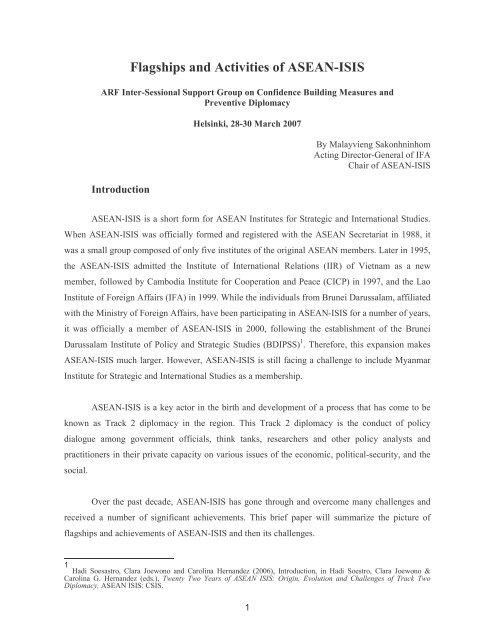
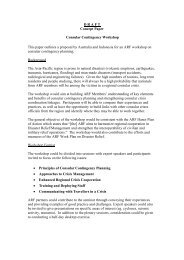
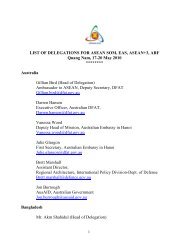
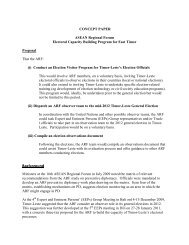
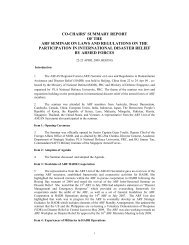
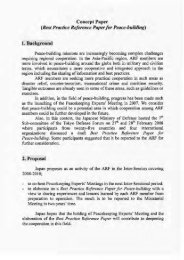
![10 ASAIN Presentation [Pakistan].pdf - ASEAN Regional Forum](https://img.yumpu.com/50649810/1/190x143/10-asain-presentation-pakistanpdf-asean-regional-forum.jpg?quality=85)
